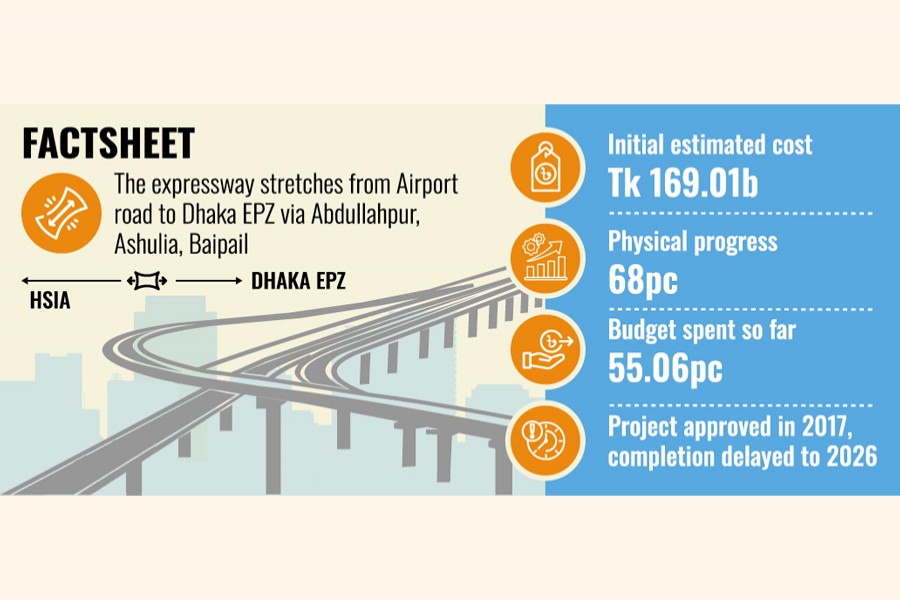Dhaka-Ashulia Elevated Expressway Project
Tk 5.16b more sought amid delays, design flaws

Published :
Updated :

The Bridges Division under the Ministry of Road Transport and Bridges has sought approval for an additional Tk 5.16 billion for the Dhaka-Ashulia Elevated Expressway project, pushing the project's cost beyond its already-revised outlay of Tk 175.53 billion.
If approved, the total revised budget will increase to Tk 180.69 billion.
Connecting Hazrat Shahjalal International Airport to Abdullahpur, Ashulia, Baipail, and the Dhaka EPZ area, the project -- aimed at linking Dhaka with 30 districts and easing industrial congestion to boost trade -- did not initially include funds for land acquisition, prompting the division to seek additional financing eight years after its approval, according to Planning Commission officials.
In a letter to the Commission, the Bridges Division warned that construction of a critical 9-km stretch of the expressway could come to a halt without the required funds, potentially triggering substantial compensation claims from the contractor under the terms of the contract.
The Dhaka-Ashulia Elevated Expressway project was approved by the Executive Committee of the National Economic Council (ECNEC) in October 2017 at an estimated cost of Tk 169.01 billion. The project aimed to build 24 km of elevated expressway, 14.28 km of connecting roads, and 10.84 km of ramps by June 2022.
However, delays in initiating construction extended the deadline by four years, with the revised completion target now set for June 2026. The revised project also includes Chinese loans worth Tk 96.92 billion.
Despite the extension and additional funding, the project continues to face significant challenges.
A recent inspection by the Implementation Monitoring and Evaluation Division (IMED) under the Planning Ministry revealed that the project's overall physical progress stands at just 68 per cent, with only one year remaining before its extended deadline.
Financial progress also remains sluggish, with only 55.06 per cent of the total cost spent so far. The IMED report expressed concern that the remaining work is unlikely to be completed within the stipulated timeframe.
One of the major hurdles identified in the report is the complexity of relocating utility lines, including gas pipelines, power cables, water pipes, and telecom connections. These issues have repeatedly disrupted construction activities.
The Bangladesh Bridge Authority (BBA), despite having available funds, allowed construction work to begin before utility relocation was completed. This decision led to frequent work stoppages as unshifted utility lines blocked construction in various sections.
As a result, key areas of the 24-km expressway, including Ashulia, Baipayl, and Nabinagar, remain inaccessible to construction teams, delaying crucial activities such as piling, foundation work, and ramp installation, according to the IMED report.
Inadequate Utility Mapping
The report also criticised the initial feasibility study, conducted by the Bangladesh University of Engineering and Technology (BUET), for failing to accurately map underground and overhead utility lines.
This oversight resulted in the absence of a proper utility relocation plan and caused recurring disruptions during construction.
A senior IMED official said the delays in utility relocation are not merely technical issues but also reflect systemic flaws in planning, coordination, and institutional efficiency.
"If these issues are not resolved urgently, the Dhaka-Ashulia Expressway risks becoming a glaring example of mismanaged infrastructure development," the official warned.
In addition to these challenges, several components missing from the original plan were later added to the project.
These include 15.28 km of at-grade service roads to facilitate access, two new two-lane bridges to improve connectivity, and a new flyover at Nabinagar to better integrate the expressway with the existing road network.
Also, the revised plan incorporates modern toll plazas with electronic toll collection (ETC) systems, administrative buildings, and security facilities.
jahid.rn@gmail.com


 For all latest news, follow The Financial Express Google News channel.
For all latest news, follow The Financial Express Google News channel.